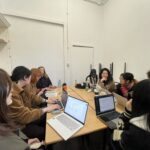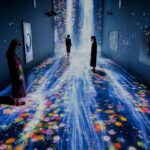Introduction
Qianhan Pan’s curatorial research demonstrates a thoughtful, critically engaged exploration of material memory and cultural transmission. Her exhibition concept “Trace and Transmission” at Summerhall, alongside the blog development, shows strong alignment with contemporary curatorial practices, and offers a cohesive dialogue between materiality, temporality, and participatory engagement.
Strengths
A significant strength of this project lies in its curatorial clarity and theoretical underpinning. The theme of trace and material memory is consistently developed across the choice of artworks, space design, and audience engagement strategies. Particularly commendable is how the exhibition draws on both traditional crafts and contemporary participatory practices, creating a multi-sensory, historically layered experience.
The integration of artists such as Geyi Huang and Ayaan Ahmed demonstrates an astute curatorial eye for material processes and social narratives. Moreover, the layout plan, ethical considerations, and public programming (e.g., Daily Artist Sharing) indicate a well-rounded understanding of audience experience and inclusivity.
Qianhan’s critical reflection is evident in her independent research, such as references to Mick Wilson and Paul O’Neill’s educational turn, and Brian Hatton’s concept of looping time. This theoretical engagement enriches her curatorial positioning and aligns strongly with Learning Outcome #3.
Suggestions for Development
While the project’s conceptual coherence is strong, there are opportunities to enhance the methodological depth:
-
The participatory element around Matree, Patree could be further theorized. How might audience interventions themselves become archival material or traces, extending the project’s conceptual frame?
-
The ethical discussion is thoughtful but could benefit from a brief mention of how consent and anonymity will be practically managed during the participatory moments (e.g., signage, guidance for participants).
-
The budget is realistic, but public engagement (£400) could be broken down more specifically (e.g., materials for workshops, accessibility accommodations), which would further strengthen feasibility.
In addition, while the proposed publication project is exciting, further clarification on how it might circulate post-exhibition (e.g., digital distribution, community libraries) would strengthen the idea of extending the “trace” beyond the physical exhibition.
Questions for Further Reflection
-
How does the curatorial strategy differentiate between preserving memory and actively transforming it?
-
In what ways might the traces created during the exhibition (e.g., audience interventions, conversations) themselves become future curatorial material?
Conclusion
Overall, Qianhan Pan presents a deeply reflective and materially sensitive curatorial project. “Trace and Transmission” successfully interweaves historical consciousness with contemporary engagement, offering audiences an intimate and participatory encounter with cultural memory. Minor clarifications in practical delivery could further enhance an already compelling and critically grounded proposal.







